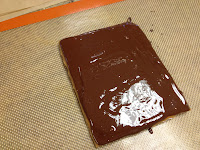 Gum paste. Is pretty much like a stiff play-dough material that gets harder when you let it set uncovered (also very much like play-dough). Its really great for sculpting, when we did gummies in the Chocolates and Confections class we were able to mold things like worms or bears or other 3D shapes if we chose to.
Gum paste. Is pretty much like a stiff play-dough material that gets harder when you let it set uncovered (also very much like play-dough). Its really great for sculpting, when we did gummies in the Chocolates and Confections class we were able to mold things like worms or bears or other 3D shapes if we chose to.
We prepped bases out of gum paste for roses and calla lilies. The calla lilies are pretty straight forward to make because the base is just the yellow baby corn looking spadix in the center. You want to tint your gum paste with yellow colouring. I used one drop (you could maybe use two drops) of an oil based food colouring to a fist full of gum paste. You then want to kneed it together with gloved hands until the colour is fully distributed. The motion is going to resemble kneading dough or pulling taffy.
 |
| The three different sizes of rose bases are shown with the calla lily spadix. |

Rose bases can be made for full blooms, half blooms, and for buds. The process is the same, but the sizes are going to range from skinny Hershey Kiss size to candy corn size.
The process is to use an 18 or 20 gauge floral wire (22 gauge for the rose buds). Make a hook at one end of the 6" wire, the hook is to help give a stronger base for the gum paste to attach to since it will become heavy as more petals are added to the rose shape. Form a ball out of the gum pate (for the full bloom the ball will be slightly smaller then a 25 cent gum ball, for the bud the size of a marble). Pinch one end of the ball to make a cone. Dip the floral wire in egg whites, and push this into the gum paste. Pinch the fat end of the gum paste so that it adheres to the wire, if the gum paste gets sticky you can use cornstarch on your hands to keep it dry.
 |
| Showing the ball next to the finished rose bud base. |
For piping we practiced cornelli's, brushed embroidery, piped embroidery, string work/extension work, borders, and dotted swiss. For the practicing, we made individual batches of royal icing. This size is good for practice work or small amounts of piping.
16 oz. Confectioners sugar, 10x, sifted
3 oz. Egg whites
1/4 t. Cream of tartar
MOP: with a paddle attachment mix all ingredient to incorporation on low. Increase speed to moderate speed and let mix for approximately 7 minutes, until the icing is of toothpaste consistency. Cover immediately with plastic to the surface and then a damp cloth on top of the plastic.
 |
| Cornelli Lace |
Cornelli Lace:
use a #0 or #1 round tip
This type of shape is very traditional. It essentially is like making a lot of cursive "e", "m", and "w" shapes connected together to make a fine line squiggle design.
 |
| Some examples of Chef's Piped Embroidery |
use a #00, #0, or #1 round tip
This time is a free form type of piping where you are trying to mimic embroidery or needle point work with a very fine tip.
Brushed Embroidery:
use a #1 round tip
This technique produces a very organic lacy design that can be carried out in clumps or along the whole cake. This technique needs egg whites and a fine tooth brush. You will need to start with piping a organ shaped heart. Then dip the brush in egg whites and brush in against the piped icing. Pipe another shape and immediately brush the piped line in again. Continue in this manner, piping a new shape next to the last one.
 |
| String work along the sides, brushed embroidery on the top. |
String Work / Extensions:
use a #0 or #1 round tip
Extensions are really not used a lot in the US but are piping bridges, built up dimensionally so you can pip extensions from the bridge to a platform. String work is where you pipe a dot on the cake, and while applying pressure pull out from the cake and let the icing fall naturally giving a cup shape before you bring the tip back to the cake. Creating a clean and even drop like laced strings.
Dotted Swiss:
use a #2 or #3 round tip
This style is creating offset ordered dots along the sides of your cake. You can determine the spacing or number of dots used in a cluster. The important thing to remember is the second row of dots is offset from the first, and even and odd number rows match up. The important thing to remember with this technique is to not leave tips on your dots, soften each dot immediately with egg whites to create a smooth professional looking finish instead of Hershey Kiss like tips.
Borders:
use a #5 or #8 round tip/star tip
Teardrop/Pear/Bead - you can either link them together or pipe each bead individually
Shells/Scrolls - use a star tip to create a seamless effect
Reverse Rosette - use a star tip, pipe tight cursive "e" then an "a"
 |
| Reverse Rosettes |
 |
| Scrolls |
 |
| Shells |
 |
| String work, cornelli lace on top |
 |
| Teardrop/pearl/bead L: individually piped R: strung together |


































